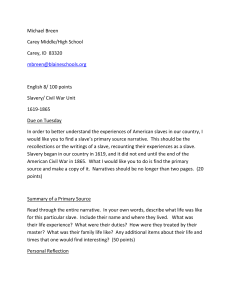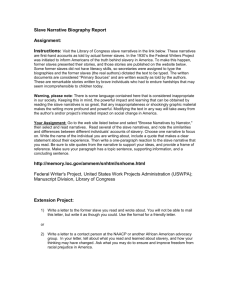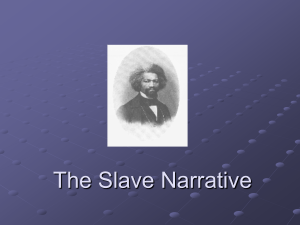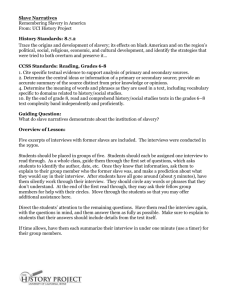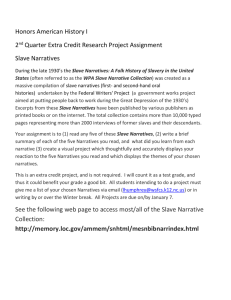Slave Narrative Found Poems 11th 12th
advertisement
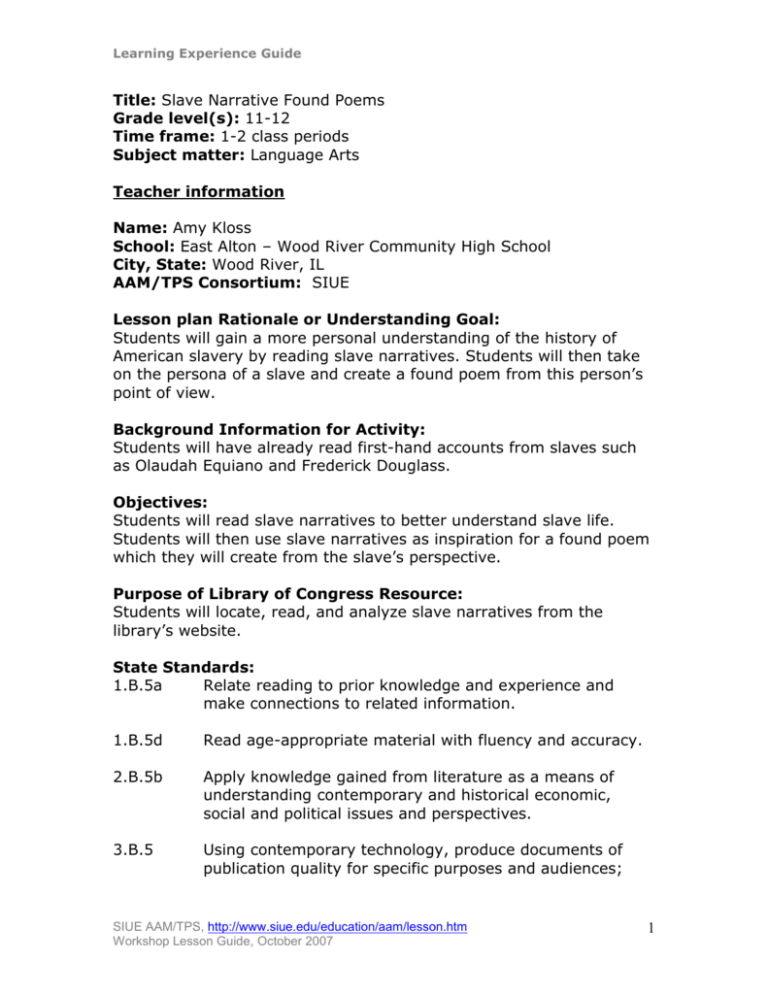
Learning Experience Guide Title: Slave Narrative Found Poems Grade level(s): 11-12 Time frame: 1-2 class periods Subject matter: Language Arts Teacher information Name: Amy Kloss School: East Alton – Wood River Community High School City, State: Wood River, IL AAM/TPS Consortium: SIUE Lesson plan Rationale or Understanding Goal: Students will gain a more personal understanding of the history of American slavery by reading slave narratives. Students will then take on the persona of a slave and create a found poem from this person’s point of view. Background Information for Activity: Students will have already read first-hand accounts from slaves such as Olaudah Equiano and Frederick Douglass. Objectives: Students will read slave narratives to better understand slave life. Students will then use slave narratives as inspiration for a found poem which they will create from the slave’s perspective. Purpose of Library of Congress Resource: Students will locate, read, and analyze slave narratives from the library’s website. State Standards: 1.B.5a Relate reading to prior knowledge and experience and make connections to related information. 1.B.5d Read age-appropriate material with fluency and accuracy. 2.B.5b Apply knowledge gained from literature as a means of understanding contemporary and historical economic, social and political issues and perspectives. 3.B.5 Using contemporary technology, produce documents of publication quality for specific purposes and audiences; SIUE AAM/TPS, http://www.siue.edu/education/aam/lesson.htm Workshop Lesson Guide, October 2007 1 Learning Experience Guide exhibit clarity of focus, logic of organization, appropriate elaboration and support and overall coherence. 3.C.5a Communicate information and ideas in narrative, informative and persuasive writing with clarity and effectiveness in a variety of written forms using appropriate traditional and/or electronic formats; adapt content, vocabulary, voice and tone to the audience, purpose and situation. Resources or Materials needed: Slave Narratives from the Federal Writers’ Project: http://memory.loc.gov/ammem/snhtml/snhome.html Methods: Modeling Activity: 1. On a projector, teacher will access the Library of Congress website and show students how to locate the link of slave narratives from the Federal Writers’ Project. 2. Teacher will read through one narrative with the class. 3. Teacher will ask what this document can teach one about slavery in general. 4. Teacher will ask what this document can teach one about this particular slave. 5. Teacher will then read a found poem he/she has created from the example slave narrative. Student Activity: 1. Each student will be assigned the name of one former slave whose narrative can be found on the Library of Congress website. 2. Students will begin by locating and reading the narrative. 3. On moodle, each student must post a blog that explains what the narrative teaches him/her about slavery in general and this slave’s life in particular. In this blog entry, students should also make connections to the narratives read in class (Equiano and Douglass). 4. Finally, each student will write a found poem using words and phrases from his/her assigned narrative. The student must take on the persona of the former slave and will, therefore, write from the first person point of view. 5. In any remaining time, students will read other students’ blogs and comment on any connections they may be able to make. SIUE AAM/TPS, http://www.siue.edu/education/aam/lesson.htm Workshop Lesson Guide, October 2007 2 Learning Experience Guide Formal Assessment: o Students’ blogs will be evaluated based on their explanation of slave life in general and one former slave’s life specifically. o Students’ found poems will be evaluated on the 6 Write Traits: ideas, organization, word choice, sentence fluency, voice, and conventions. SIUE AAM/TPS, http://www.siue.edu/education/aam/lesson.htm Workshop Lesson Guide, October 2007 3
